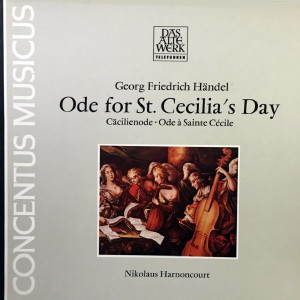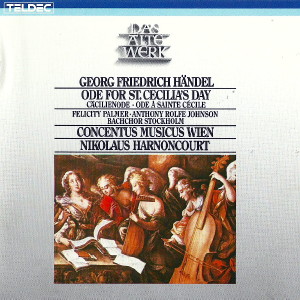 |
1 LP -
6.42349 AW - (p) 1978
|

|
| 1 CD -
8.42349 ZK - (c) 1984 |
|
Georg Friedrich
Händel (1685-1759)
|
|
|
|
|
|
|
|
| Ode for St. Cecilia's Day |
|
49' 28"
|
|
|
|
|
|
1. Ouverture (Larghetto
e staccato - allegro; Menuet)
|
|
| |
|
2. Recitativo (Tenor) "'From
Harmony, from heav'nly Harmony"
|
8' 45" |
| |
A1 |
| 3. Accompagnato. Larghetto e
piano (Tenor) "When Nature underneath
a heap" |
|
| |
|
| 4. Chorus. Largo "From Harmony,
from heav'nly Harmony" |
3' 51" |
|
A2 |
| 5. Aria. Adagio-Andante
(Soprano) "What passion cannot Music
raise and quell!" |
8' 39" |
|
A3 |
| 6. Aria (Tenor) - Chorus "The
Trumpets loud clangor excites us to
arms" |
3' 53" |
|
A4 |
| 7. March |
1' 47" |
|
B1 |
| 8. Aria. Andante (Soprano) "The
soft complaining Flute" |
4' 39" |
|
B2 |
| 9. Aria. Allegro (Tenor) "Sharp
Violins proclaim" |
4' 30" |
|
B3 |
| 10. Aria. Larghetto e mezzo
piano (Soprano) "But oh! what art can
teach" |
4' 00" |
|
B4 |
| 11. Aria. Alla Hornpipe
(Soprano) "Orpheus could lead the
savage race" |
1' 47" |
|
B4 |
| 12. Accompagnato. Largo
(Soprano) "But bright Cecilia raid's
the wonder high'r" |
0' 35" |
|
B5 |
| 13. Chorus. Grave - Un poco più
Allegro "As from the pow'r of sacred
lays" |
6' 59" |
|
B6 |
|
|
|
|
Felicity Palmer,
Sopran
|
|
Anthony Rolfe
Johnson, Tenor
|
|
|
|
| Bachchor
Stockholm / Anders Öhrwall, Leitung |
|
|
|
CONCENTUS MUSICUS WIEN (mit
Originalinstrumenten)
|
|
| -
Alice Harnoncourt, Violine |
-
Leopold Stastny, Traversière |
|
| -
Walter Pfeiffer, Violine |
-
Jürg Schaeftlein, Oboe
|
|
| -
Peter Schoberwalter, Violine |
-
Paul Hailperin, Oboe |
|
| -
Wilhelm Mergl, Violine |
-
Milan Turkovic, Fagott
|
|
| -
Anita Mitterer, Violine |
-
Otto Fleischmann, Fagott |
|
| -
Ingrid Seifert, Violine |
-
Hermann Schober, Naturtrompete
|
|
| -
Veronika Schmidt, Violine |
-
Richard Rudolf, Naturtrompete |
|
| -
Richard Motz, Violine |
-
Kurt Hammer, Pauken
|
|
-
Gerold Klaus, Violine
(1,3,5,6,7,8,9,10,11,12)
|
|
|
| -
Micaëla Comberti, Violine (1,3,5,6,7,8,9,10,11,12) |
|
|
| -
Alison Bury (4,6,14) |
|
|
| -
Christin Buchner, Violine (4,6,14) |
|
|
| -
Kurt Theiner, Viola |
|
|
| -
Josef de Sordi, Viola |
|
|
-
Friedrich Hiller, Violoncello
(1,3,5,6,7,8,9,10,11)
|
|
|
-
Nikolaus Harnoncourt, Violoncello
|
|
|
| -
Wouter Möller, Violoncello
(4,6,14) |
|
|
| - Eduard Hruza,
Violone |
|
|
-
Herbert Tachezi, Orgel und
Cembalo
|
|
|
-
Johann Sonnleitner, Cembalo
(4,6,14)
|
|
|
| -
Toyohiko Satoh, Theorbe |
|
|
|
|
| Nikolaus Harnoncourt, Gesamtleitung |
|
|
Luogo e data
di registrazione
|
Festsaal der Freien
Waldorfschule, Brema (Germania) -
ottobre 1977
Casino Zögernitz, Vienna (Austria) -
febbraio 1978 |
|
Registrazione
live / studio
|
| studio |
Producer / Engineer
|
| - |
Prima Edizione
CD
|
Teldec "Das Alte Werk" -
8.42349 ZK - (1 cd) - 49' 28" - (c) 1984
- AAD
|
Prima
Edizione LP
|
Telefunken "Das Alte Werk" -
6.42349 AW - (1 lp) - 49' 28" - (p) 1978
|
|
|
Notes
|
The Roman martyr
Cecilia, whose veneration and festive
day (22nd November) have been
observed since the 5th
century, became the
patron saint of music
in the 14th or 13th century and
in particular music as god-given "harmonia",
representing the harmony of the world.
As verified hy
pictures since the 14th
century, the organ became
the attribute of the saint as the
specific instrument most perfectly embodying
the Christian concept of harmony. In
Raffael's famous painting the broken instruments
lying on the floor
provide eloquent evidence of how superior
the organ was to them, and how very
much it had become
a symbolic instrumental the beginning
of the 16th century. With
such a traditional background
it was inevitable that the festivities
connected with the saint were observed
with far-reaching
musical functions. It
was at least also for this purpose
that Cecilian
associations were
formed, initially tn Rome
towards the end of the
16th century and later in other
countries, including England in the
wake of the fresh blossomming
of church and court music in the
Restoration under Charles II, since
the founding of the London St. Cecilia
Society in 1683. The
anthem as the preferred genre of
courtly festive and homage music was
transferred to the Cecilian
feast. The writing and composing of
Cecilian odes became a favourite task
in English court circles attracting
such great composers as Purcell (l692)
and Handel, and such insignificant
ones as Jeremiah Clark
and Thomas Clayton. The continuity of
the ode to St. Cecilia as an "institution"
surpassing all political changes is
clearly underlined by
the two works which the greatest English
poet of that epoch, John
Dryden. wrote for the 22nd Novembre.
The "Ode for St Cecilia`s
Day" was written in 1687,
two years after Dryden's conversion
to Roman Catholicism and at the height
of power of the Caholic
King James II. "Alexanders Feast", a
classical scholarly variation of the
Cecilian theme, was written ten years
later, that is to say after
the "Glorious Revolution". For a whole
century both poems
were accepted as the definitive
classical Cecilian
texts. Handel set both of them to
music.
Ludwig Finscher
English
translations by Frederick A.
Bishop
|
|
Nikolaus
Harnoncourt (1929-2016)
|

|

|
|